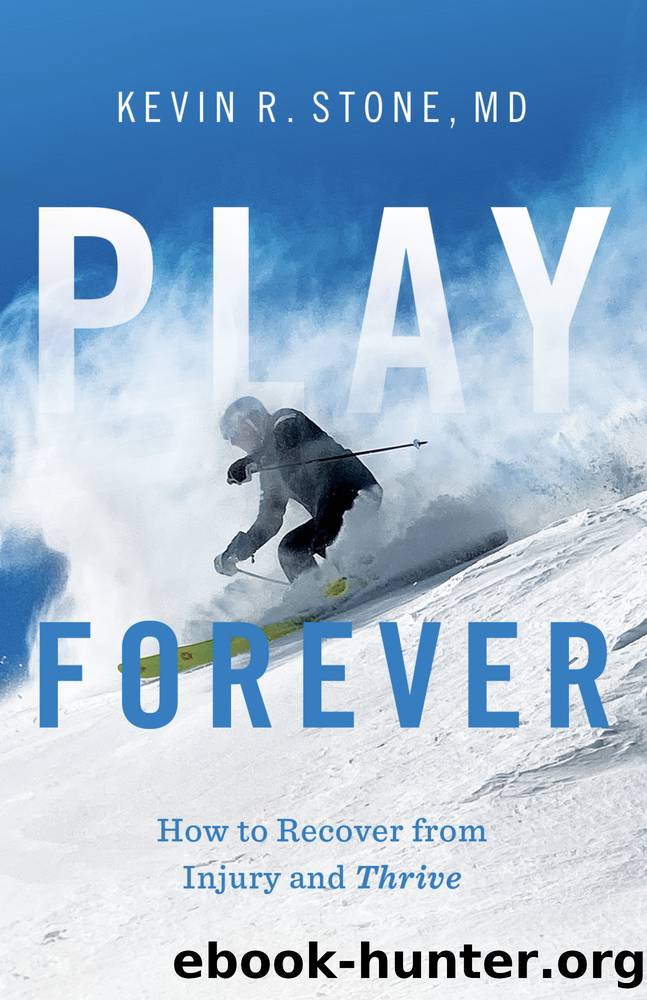Play Forever : How to Recover from Injury and Thrive (9781544526775) by Stone Kevin R

Author:Stone, Kevin R.
Language: eng
Format: epub
Publisher: Bookbaby
Published: 2021-01-15T00:00:00+00:00
Biologic Treatments
Anterior Cruciate Ligament (ACL)
The knee joint
The ACL is a broad, thick cord the size of your index finger, with long collagen strands woven together in a way that allows it to withstand up to five hundred pounds of force in young, healthy people. It connects the thigh bone to the shin bone and is a key stabilizer of your knee, guiding your tibia (shin bone) through a normal, stable range of motion. When the ACL tears, it unravels like a braided rope and does not heal on its own.
The ACL is the most commonly injured ligament in the kneeâthree hundred thousand tears each year in the US alone. Females, for many different reasons, are more likely to injure their ACL than males. People often tear the ACL by twisting the knee while changing direction rapidly, slowing down from running, or landing from a jump. The thigh bone moves past where the ligament can stretch, producing the famous âpop.â Once broken, it may partially heal to the surrounding tissues, but the ligament rarely regains its normal connections. While some patients have âACL independentâ knees and donât develop significant instability after rupture, most athletic people need their ACL to provide stability and to protect the meniscus tissues that rest upon the tibial plateau. Left unstable, approximately 80 percent of injured people will eventually go on to develop meniscus tears and 50 percent will develop knee joint arthritis.
Once torn, the optimal time to restore stability is immediately. While there has been considerable debate about the timing of surgery, all collagen-based tissues start scarring and shrinking within minutes of tearing. The ACL fibers are similar to a climbing rope, which once stretched past their limit, suffer from internal disruptions of most of the fibersâeven when the outside sheath looks intact.
Efforts to perform suture repair of the torn ACL tissue have had only selective success, despite efforts to add scaffolds, stem cells, and growth factors to the injured tissue. And those limited successes were obtained only when most of the ligament was still intact, acting as a scaffold to which the injured tissues could adhere.
In my hands, primary repair works well when the tear is partial, located near the ligament origin on the femur, and the patients are older. Young, healthy, aggressive males rarely protect their primary repairs long enough to provide a successful outcome. Future devices most likely will be designed to work as temporary ligaments while inducing normal tissue remodeling.
In the initial assessment of ACL injuries, a common diagnostic error is missing associated knee injuries when confronted with the more obvious ACL rupture. When the ACL ruptures, more than just the ACL is stretched. The most common secondary injuries involve the meniscus, the articular cartilage, and the secondary ligamentous tissues, such as the outside back corner of the knee. If these tissues are ignored or resected, and not surgically repaired, the knees fail quickly.
ACL reconstructions with patientsâ own tissuesâusually hamstring or patella tendon graftsâhave not evolved very much. In the twenty-first century, we should not be taking one part of a person to rebuild another part.
Download
This site does not store any files on its server. We only index and link to content provided by other sites. Please contact the content providers to delete copyright contents if any and email us, we'll remove relevant links or contents immediately.
When Breath Becomes Air by Paul Kalanithi(7274)
Why We Sleep: Unlocking the Power of Sleep and Dreams by Matthew Walker(5657)
Paper Towns by Green John(4178)
The Immortal Life of Henrietta Lacks by Rebecca Skloot(3833)
The Sports Rules Book by Human Kinetics(3597)
Dynamic Alignment Through Imagery by Eric Franklin(3499)
ACSM's Complete Guide to Fitness & Health by ACSM(3472)
Kaplan MCAT Organic Chemistry Review: Created for MCAT 2015 (Kaplan Test Prep) by Kaplan(3429)
Introduction to Kinesiology by Shirl J. Hoffman(3306)
Livewired by David Eagleman(3134)
The River of Consciousness by Oliver Sacks(2998)
Alchemy and Alchemists by C. J. S. Thompson(2917)
The Death of the Heart by Elizabeth Bowen(2909)
Descartes' Error by Antonio Damasio(2744)
Bad Pharma by Ben Goldacre(2735)
The Gene: An Intimate History by Siddhartha Mukherjee(2500)
Kaplan MCAT Behavioral Sciences Review: Created for MCAT 2015 (Kaplan Test Prep) by Kaplan(2494)
The Fate of Rome: Climate, Disease, and the End of an Empire (The Princeton History of the Ancient World) by Kyle Harper(2443)
The Emperor of All Maladies: A Biography of Cancer by Siddhartha Mukherjee(2438)
